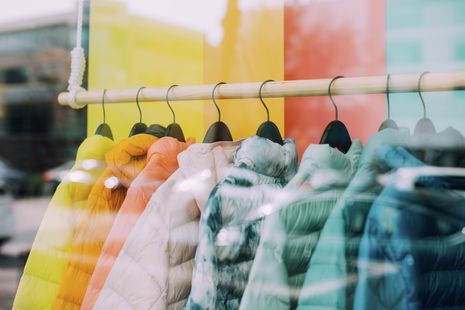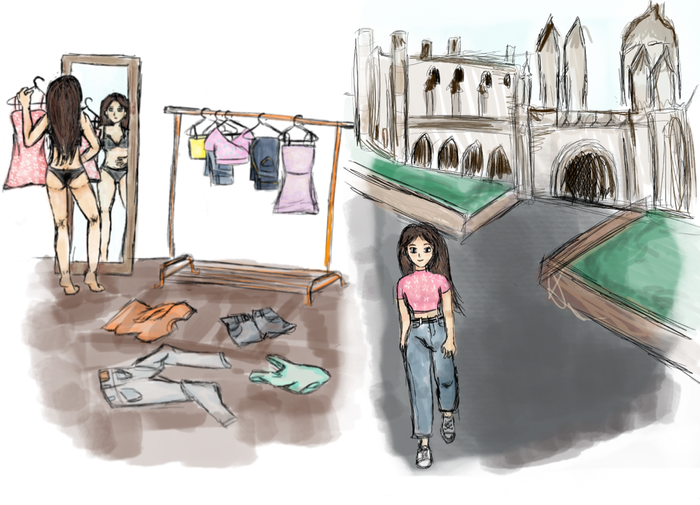Discount detox: a year without fast fashion
Columnist Eleanor Antoniou reflects on her year banning herself from fast fashion, celebrating how it has made her style more creative as well as more ethical

When lockdown first began in March 2020, online shopping on fast fashion sites became both a ray of hope and a mindless addiction. I spent hours scrolling endlessly through the tiny squares of clothes. It was a way to escape the pandemic and dream of the days when I could go out again, of the clothes I would wear once everything went back to normal. Many fast fashion brands began to offer free shipping without any minimum spend, and brands such as Urban Outfitters created a whole week of deals, with a new special discount each day.
Retail therapy became my reality as I sought to escape lockdown through new purchases. I remember finding floral dresses on ASOS which I had no intention of buying but which I fantasised about wearing in a Covid-free summer. Quickly, however, lockdown made me recognise this addiction to fast fashion sites. At the same time, I became increasingly aware of the Pay Up movement, which campaigns for brands to pay their garment workers fair wages.
“My fast fashion ban has surprisingly been much easier than I expected it to be. It has changed the way I see my clothes and has made me think more deeply about my style”
I was shocked by the realities behind fast fashion, something which I had been vaguely aware of before, but which I had always pushed to the back of my mind: surely not every high-street brand could be a part of this problem? What I discovered was an ugly truth, hidden behind the gleaming websites and perfect models, which led me to give up fast fashion altogether. I promised myself at the end of September 2020 that I would go a whole year without making any fast fashion purchases; I deleted their apps from my phone and downloaded Depop and Vinted instead.
I was horrified to learn about the lives that so many garment workers lead, often stripped of their dignity, forced to survive on inadequate pay, vulnerable and spending long hours in unsafe and unhealthy environments. 80% of these garment workers are women, and as a feminist, I was appalled that I had been supporting brands who treated their female employees in this way. A recent study by ActionAid found that in Bangladesh, 80% of garment workers have experienced or witnessed sexual violence or harassment at work. At the start of this year a woman was raped and killed at her H&M supplier factory in India.
My fast fashion ban has surprisingly been much easier than I expected it to be. It has changed the way I see my clothes and has made me think more deeply about my style. I have learnt to be more careful when I buy new items, now unable to purchase a haul of several pieces at once, and instead shopping for one piece at a time. I have been compelled to think about what clothes I actually need, searching for these on second-hand apps, rather than casually scrolling through fast fashion sites with no particular item in mind.
Now, when I am browsing for clothes, I ask myself whether they will last me a long time, which pieces will match the rest of my wardrobe and which items I can adapt to fit different occasions. My aim is to build a timeless wardrobe which will last me for years to come, in which each item is something I love, rather than merely a part of a fleeting, current trend which will go out of style within months.
“Rather than something I bought on a whim because it was on discount at a major fast fashion brand, every piece that I own has become something to treasure”
I have also become more creative with my style, re-wearing my old clothes in new ways, and matching different pieces together rather than buying new things. I have learnt not to be ashamed of outfit repeating: in the past I have rushed into buying dresses for formals, which I didn’t actually like very much, but which I thought were preferable to wearing the same thing as the month before. Now for special occasions I must plan ahead more with my outfits, without the option of ASOS’s next-day delivery. I thought this might be difficult, but I found that it took away the stress of always needing to wear something new and perfect. I am more comfortable in the clothes that I already own and love, and can now dress up in pieces that I know I feel confident in, rather than pieces I have rushed to buy in moments of panic.
Shopping has transformed into a fun challenge or hobby since I left fast fashion behind. I have loved the excitement and satisfaction of putting together new looks in ethical ways. Although I have not made many new purchases over the last year, the pieces which I did buy have all added something special to my wardrobe. I spent a long time searching for the perfect pair of jeans with the right shade of blue and the right cut, while in the past I might have settled for a less than perfect pair just because it was easy to buy from a fast fashion brand without thinking too deeply about it. I have also found some unique pieces which I love: most recently, I bought the prettiest cardigan from Depop which I will be wearing all winter. I even upcycled some old clothes, making a gingham cami dress out of an old blouse.
Of course, not everyone has the privilege of being able to give up fast fashion altogether: shopping second-hand can be more expensive, it is a lot more time consuming, and it is often difficult to shop in bigger sizes. As someone who could afford to give up fast fashion, however, the year has been eye-opening: I feel more confident in my outfits and more creative in my style. I love that my clothes have become more meaningful: I can open my wardrobe and feel a deeper connection to each item that shines out at me. Rather than something I bought on a whim because it was on discount at a major fast fashion brand, every piece that I own has become something to treasure.
 News / Eight Cambridge researchers awarded €17m in ERC research grants27 December 2025
News / Eight Cambridge researchers awarded €17m in ERC research grants27 December 2025 News / Downing investigates ‘mysterious’ underground burial vault 29 December 2025
News / Downing investigates ‘mysterious’ underground burial vault 29 December 2025 Lifestyle / Ask Auntie Alice29 December 2025
Lifestyle / Ask Auntie Alice29 December 2025 Sport / Hard work, heartbreak and hope: international gymnast Maddie Marshall’s journey 29 December 2025
Sport / Hard work, heartbreak and hope: international gymnast Maddie Marshall’s journey 29 December 2025 Interviews / Meet Juan Michel, Cambridge’s multilingual musician29 December 2025
Interviews / Meet Juan Michel, Cambridge’s multilingual musician29 December 2025











